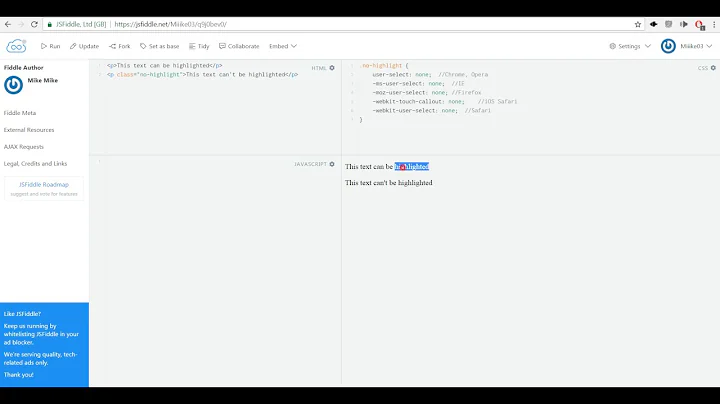How do I disable text selection with CSS or JavaScript?
Solution 1
<div
style="-moz-user-select: none; -webkit-user-select: none; -ms-user-select:none; user-select:none;-o-user-select:none;"
unselectable="on"
onselectstart="return false;"
onmousedown="return false;">
Blabla
</div>
Solution 2
UPDATE January, 2017:
According to Can I use, the user-select is currently supported in all browsers except Internet Explorer 9 and earlier versions (but sadly still needs a vendor prefix).
All of the correct CSS variations are:
.noselect {
-webkit-touch-callout: none; /* iOS Safari */
-webkit-user-select: none; /* Safari */
-khtml-user-select: none; /* Konqueror HTML */
-moz-user-select: none; /* Firefox */
-ms-user-select: none; /* Internet Explorer/Edge */
user-select: none; /* Non-prefixed version, currently
supported by Chrome and Opera */
}<p>
Selectable text.
</p>
<p class="noselect">
Unselectable text.
</p>Note that it's a non-standard feature (i.e. not a part of any specification). It is not guaranteed to work everywhere, and there might be differences in implementation among browsers and in the future browsers can drop support for it.
More information can be found in Mozilla Developer Network documentation.
Solution 3
Try this CSS code for cross-browser compatibility.
-webkit-user-select: none;
-khtml-user-select: none;
-moz-user-select: none;
-o-user-select: none;
user-select: none;
Solution 4
You can use JavaScript to do what you want:
if (document.addEventListener !== undefined) {
// Not IE
document.addEventListener('click', checkSelection, false);
} else {
// IE
document.attachEvent('onclick', checkSelection);
}
function checkSelection() {
var sel = {};
if (window.getSelection) {
// Mozilla
sel = window.getSelection();
} else if (document.selection) {
// IE
sel = document.selection.createRange();
}
// Mozilla
if (sel.rangeCount) {
sel.removeAllRanges();
return;
}
// IE
if (sel.text > '') {
document.selection.empty();
return;
}
}
Soap box: You really shouldn't be screwing with the client's user agent in this manner. If the client wants to select things on the document, then they should be able to select things on the document. It doesn't matter if you don't like the highlight color, because you aren't the one viewing the document.
Solution 5
I'm not sure if you can turn it off, but you can change the colors of it :)
myDiv::selection,
myDiv::-moz-selection,
myDiv::-webkit-selection {
background:#000;
color:#fff;
}
Then just match the colors to your "darky" design and see what happens :)
Related videos on Youtube
Comments
-
daviddarx over 2 years
I am making a HTML/CSS/jQuery gallery, with several pages.
I indeed have a "next" button, which is a simple link with a jQuery click listener.
The problem is that if the user click the button several times, the text of the button is selected, and then the full line of text. In my really darky design, that is really ugly and nonsensical.
So here is my question: Can you disable text selection on HTML? If not, I'll terribly miss flash and its high level of configuration on textfields...
-
Code Spy over 5 yearsIt's 2018 :P Check n try these methods ---> freakyjolly.com/how-to-disable-text-selection-highlighting
-
-
 Yahel almost 14 yearsYou could compress this into one CSS rule. myDiv.webkit::-webkit-selection, myDiv.moz::-moz-selection, myDiv.normal::selection{ background:#000; color:#fff; }
Yahel almost 14 yearsYou could compress this into one CSS rule. myDiv.webkit::-webkit-selection, myDiv.moz::-moz-selection, myDiv.normal::selection{ background:#000; color:#fff; } -
 Kyle almost 14 years@yc: use a multiple selector, I shall edit, thanks :)
Kyle almost 14 years@yc: use a multiple selector, I shall edit, thanks :) -
daviddarx almost 14 years#galleryPagesNavigation a.normal::selection { background:#000; } #galleryPagesNavigation a.moz::-moz-selection { background:#000; } #galleryPagesNavigation a.webkit::-webkit-selection { background:#000; }
-
 Kyle almost 14 yearsYou have "normal" "moz" and "webkit" in there, remove those, copy the updated code out of this answer :)
Kyle almost 14 yearsYou have "normal" "moz" and "webkit" in there, remove those, copy the updated code out of this answer :) -
daviddarx almost 14 yearsStill don't work in safari and chrome. I keep that solution, but i also implement one work around for the rest: at each click, replace the html of the link by the html of the link. the text is then updated, and the selection go off after 1 half second!
-
Jerome almost 14 yearsThe CSS for webkit is similar to the one for Firefox, I edited the answer to add it.
-
mhenry1384 over 12 years@daviddarx Works in Chrome 17 and Safari 5.
-
 Robert about 12 yearsSoap box rebuttal: I have a button which, when clicked, runs some javascript to change the scale of a picture. There is no reason for the user to select the "+" or "-" inside that button, but most web browsers will end up with the text selected after a few button clicks. Similarly, if you're doing drag-and-drop via javascript, you don't want to select the things you drag something over. That said, I appreciate the fact that you still answered the question even though you disagree with the goal.
Robert about 12 yearsSoap box rebuttal: I have a button which, when clicked, runs some javascript to change the scale of a picture. There is no reason for the user to select the "+" or "-" inside that button, but most web browsers will end up with the text selected after a few button clicks. Similarly, if you're doing drag-and-drop via javascript, you don't want to select the things you drag something over. That said, I appreciate the fact that you still answered the question even though you disagree with the goal. -
devdavid about 12 yearsI'll concede that there are circumstances where it can be a valid design choice. But the question mentioned he'd miss Flash with the implication that he'd miss being able to control the user's client. I disagree with that mode of thinking. As a user, I do not like site's redefining how my local software works. It's also an accessibility issue.
-
BoltClock about 12 years"correct CSS variations"...? The only correct CSS "variation" is
user-select. -
 Blowsie about 12 yearsokay so the others are vendor specific prefixes, I'd presume anyone else would class those are correct variations.
Blowsie about 12 yearsokay so the others are vendor specific prefixes, I'd presume anyone else would class those are correct variations. -
arkon over 11 years@jsumners There are plenty of circumstances. Do some out-of-the-box thinking and you'll come up with multiple scenarios. Just because browsers enable this by default does not mean we as programmers should conform. Besides, mobile computing is doing away with traditional means of text selection. So it's becoming increasingly relevant. You make it sound like it's some kind of obsolete hack or something, it's a supported feature (see answers above.)
-
devdavid over 11 years@b1naryatr0phy again, the OP specifically described a scenario in which he wanted to control the user's client purely for aesthetic reasons. His goal had nothing to do with function, be it touch or otherwise. In particular, he states that he would miss the ability to completely control the user's interaction like he could with Flash. I believe that is a broken way of developing for the web and said as much after providing a solution that doesn't rely on potentially unimplemented CSS features (at the time).
-
arkon over 11 years@jsumners Is it not the website designer's decision how a user interacts with his/her page, regardless of the aesthetic or functional purpose?
-
devdavid over 11 yearsNo. That is completely up to the client and/or user. This question is essentially the same as "how do I control the user's font size?" The answer is, you can't. Sure, you can specify all sorts of stuff in the stylesheet you deliver with the page, but I can throw thing out and use my own stylesheet to do whatever I want. Same thing with JavaScript. But who wants to do that for a random site? No, the user who finds their client altered by a site is likely to never visit it again. Read alistapart.com/articles/dao it's old but still applies.
-
arkon over 11 yearsIf it were "completely up to the end user", there we be no functional difference between one website to the next. So I honestly can't see how that makes sense. I also fail to understand how this question could be considered identical to controlling the user's font size. Font size isn't a function. Text selection is. Any true programmer would acknowledge there is a fundamental difference.
-
devdavid over 11 yearsThe implication in the question is that the web designer should have ultimate control over how the document is presented to/viewed by the user. With Flash, that sort of control is possible. With plain HTML/CSS/JavaScript, it isn't. So, yes, they are fundamentally the same question: "how do I impose my will on the user with my HTML/CSS/JavaScript?" And, again, the answer is you can't and you shouldn't. Once the data has left your server, you have zero control over how it is ultimately presented.
-
Starx over 11 yearsHa ha, Are you planning on earning all your rep with same answer? NICE :)
-
Dan almost 11 yearsEveryone should know where this works and where does not caniuse.com/user-select-none
-
Dan almost 11 yearsWorks in IE and Opera after update
-
Raja over 10 yearsprovided solution is not working for opera browser . How to set the user-select option for opera
-
JohnK over 10 yearsIs this still good in 2014?
-
MartyIX almost 9 yearsyes, it is caniuse.com/#feat=user-select-none
-
unsynchronized almost 8 yearsummm i think you mean if (typeof document.addEventListener....
-
Tim almost 8 yearsThis is all a moot point. CSS classes both let you define it as a designer, and the user can re-enable it with a user style sheet if they so desire.
-
 naXa stands with Ukraine about 3 yearseasy to be a web dev in 2021:
naXa stands with Ukraine about 3 yearseasy to be a web dev in 2021:user-select: none;is enough. -
 Arnold Parge over 2 yearsWill this affect SEO?
Arnold Parge over 2 yearsWill this affect SEO? -
Joseph Ali about 2 years:( didn't work for me
-
James William about 2 years@naXastandswithUkraine not in Safari unfortunately, and this is assuming everyone keeps their browser up-to-date, which they annoyingly don't. Still with using all the above mentioned for now. 👍







